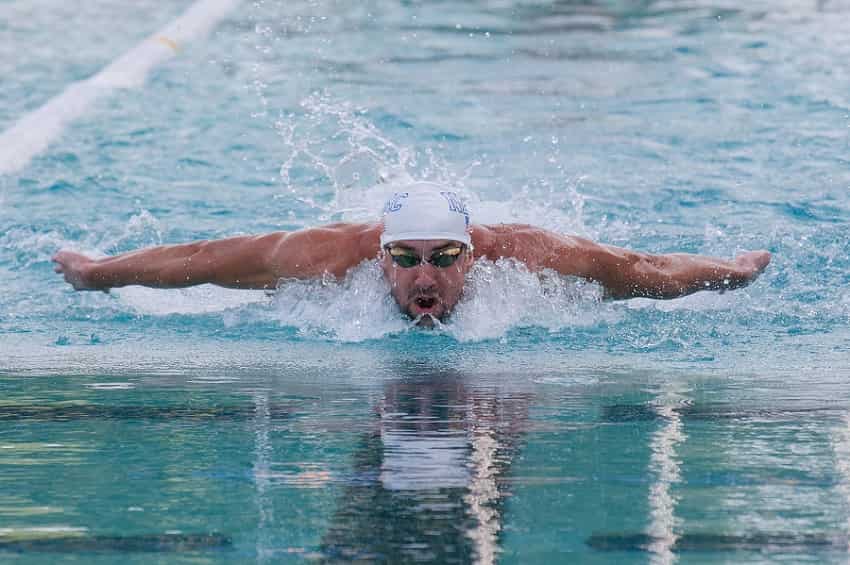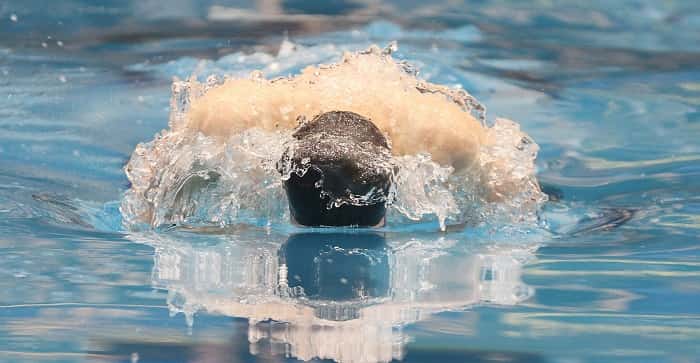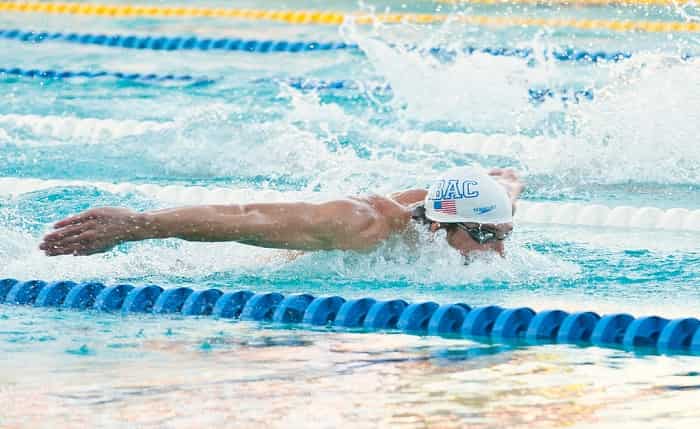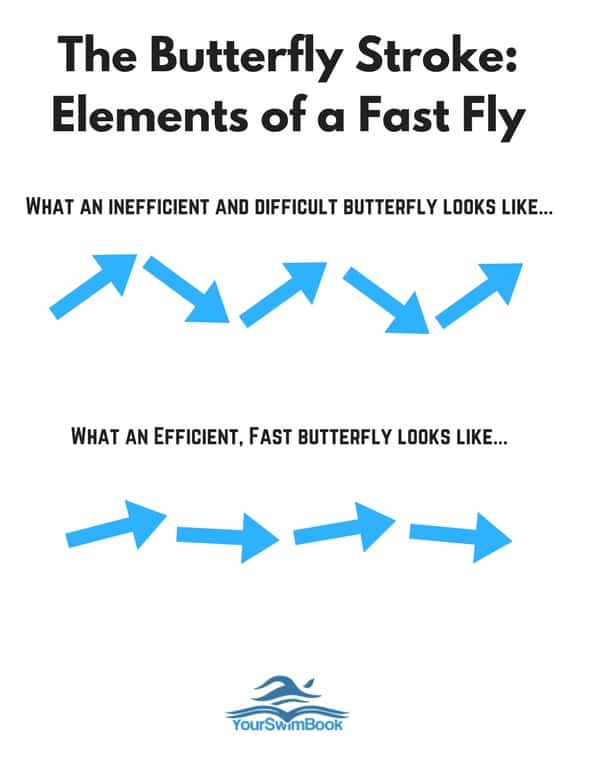From technique tips, developing a powerful underwater fly kick, to sets to help you get faster, here is everything you ever wanted to know about the butterfly stroke.
The butterfly stroke. It’s loathed by many swimmers, celebrated by some, and truly mastered by a select few.
The greatest swimmer of all time, Michael Phelps, made the swimming stroke his bread and butter over 5 Olympics on his way to winning a mind-numbing 28 Olympic medals. For most of us, however, it’s a battle to keep our head above water while moving forward in a moderately graceful manner.
From the history of the butterfly, to some random and quirky facts about it, to a quick list of tips and pointers on how to perform the butterfly stroke properly, here is everything you need to know about mastering the hardest swim stroke of them all.
We also have an extensive list of resources to help you with your butterfly stroke, from a massive guide on helping you improve your underwater dolphin kick to sets and workouts that some of the greatest butterfliers of all time used to dominate the stroke in international competition.
In this overview of the butterfly we are going to wade into the following topics:
- The History of the Butterfly Stroke.
- The Butterfly: Random Facts.
- Elements of a fast Butterfly Stroke.
- Butterfly Training Resources.
Let’s do this!
History of the Butterfly Stroke
Who is the genius that countless swimmers can credit with infusing their workouts with this haphazard two-arm stroke?
Well, it depends on who you ask.
The butterfly stroke wasn’t invented in a single, defining moment in our sport’s history. Rather, it was a handful of swimmers who were all attempting out-of-the-water recoveries while swimming breaststroke.
Officially, the International Swimming Hall of Fame recognizes Australian Sydney Cavill as the poppa of the stroke (with his father Fred being credited with being the original freestyler).
German Erich Rademacher was trying this weird new style of stroke in races in the late 1920’s, while Henry Myers, an American, raced in this haphazard new style at a race in 1933 at a YMCA in Brooklyn.
Fun Facts About the Butterfly Stroke
Who is the best butterflier of all time?
Unless you are living under a rock you already know the answer to this one.
Michael Phelps is the most celebrated butterflier of all time, with 6 Olympic gold medals in individual butterfly events (not including relays).
He still holds the world record in the 200m butterfly, having broken the record 8 different times in that race alone.
Phelps’ butterfly technique is notable for the following reasons:
- He breathes every stroke. Almost every swimmer who has come up through the age group ranks has been instructed to breathe every two strokes while doing butterfly. Phelps flouted this rule, and was able to do so because he pushed his head forward when swimming, instead of up. (More on that shortly.)
- He dominated the walls. Michael Phelps’ underwaters are a thing of legend. He took the mantle from the great dolphin kickers of the 1990s and applied it to great effect, demoralizing his competition on the final turns of races with extended underwaters.
Other notable butterfliers:
- Misty Hyman (USA). She won gold in the 200m butterfly at the 2000 Sydney Olympics, and helped make the underwater dolphin kick more mainstream. She used to swim long stretches of her races doing dolphin kick on her side below the surface of the water until FINA instituted a 15m rule on dolphin kicking.
- Denis Pankratov (RUS). Another “submariner”, Pankratov was dominant in the butterfly events during the 1990’s, preferring to use an open streamline when doing his dolphin kicks underwater and also breathing to the side, something the man he succeeded as Olympic champion in the 200m butterfly–Mel Stewart–had also mastered.
- Mary T. Meagher (USA). The original “Madam Butterfly”, she held the world records in both the 100m and 200m races for nearly twenty years each, setting the marks in 1981. She would win golds in both races (and a medley relay gold) in 1984 after missing the Moscow Games in 1980 when the United States boycotted.
- Pablo Morales (USA). One of my favorite stories from the 1992 Olympics, Morales originally set the world record in the 100m butterfly at the 1984 Olympic Trials. After a disappointing performance at the Olympics that year (where he placed 4th), and missing the team in 1988, Morales retired from the sport. After a three year break he returned, and with his father holding a picture of his recently deceased mother in the stands, Morales would finally win Olympic gold in Barcelona at the 1992 Olympics.
- Chad le Clos (RSA). The heir apparent to Michael Phelps, le Clos beat his childhood idol in the 200m butterfly at the London Olympics in 2012. Le Clos continues to be active, breaking the 100m butterfly world record at the 2016 World Short Course championships.
Is the butterfly faster than swimming freestyle?
Yes and no.
The peak speed that butterfliers reach is faster than that of any other stroke.
Why is that?
Because when we pull with both arms at the same time we are able to exert more power and speed than we can with one arm, as in freestyle.
However, this added power and speed comes at a cost during the recovery phase, where our overall speed slows below the median speed of freestylers. So for a moment the stroke is the fastest of them all, but that moment is fleeting.
Elements of a Fast Butterfly:
Quick, early catch.
Just like in freestyle where you want to have an early vertical forearm, so it is with the butterfly. Beginner butterfliers will be tempted to pull straight down towards the bottom of the pool in order to bring their head above the water.
Focus point:Finger tips down, palms backwards.
Relaxed recovery.
This requires flexibility in the shoulders, chest and back. What happens when you start to fatigue? Your arms and shoulders seize, and you begin to experience what swimmers know as “T-rex’ing”–where your arms lose it’s relaxed, Gumby-like posture and they bend and harden, shortening your stroke.
Charge forwards; not up and down.
When learning butterfly most swimmers tend to swim in an exaggerated wave pattern. They pull their heads straight-up in order to breathe, and then dive straight back down. This leads to a lot of wasted effort. When breathing and pulling through the water your focus should always be on swimming forwards.
Skim your chin across the surface of the water.
When you watch Michael Phelps breathe you notice how low of a profile he keeps when breathing–this isn’t an accident. He picks up his head as much as he needs to in order to take a breath, in no higher. This results in less wasted energy, increased efficiency, and less of the up-and-down bobbing that is so common with an inefficient fly stroke.
Two kicks per pull.
The butterfly kick has a few different functions within the overall stroke–it helps to create a little bit of propulsion, assists in creating lift to allow the swimmer to pick their head up out of the water (first kick of the stroke cycle), while the second kick drives the arms and hands forward into the catch phase of the pull.
Resources: The Butterfly Stroke
Over the past couple of years we have accumulated a vast array of articles and information on how to swim faster butterfly.
Here are some of our top picks:
- How to Develop an Awesome Underwater Dolphin Kick. Also known as the 5th stroke, the underwater fly kick has become an essential for any swimmer looking to do big things in the pool. In our flagship guide we cover it all, from the importance of ankle flexibility to improving your dolphin kick technique.
- Butterfly Sets: How to Improve Your 100m Butterfly. Michael Phelps and his coach Bob Bowman leaned on these two sets frequently to help him develop the monster backhalf that he became renown for.
- 6 Struggles of Being a Butterflier. Sure, we know the stroke is hard–but that’s not where the difficulties stop for your local butterflier. Here are a half dozen struggles that every butterfly specialist can identify with.
- How NOT to Pace Your 200m Butterfly. We all know the agony and misery that comes when we die towards the end of a race. In this hard-to-watch video a young collegiate butterflier lives up to the phrase–“Butterfly? More like butterdie!”











